Analysis of Business Environment, Organizations, and Objectives
VerifiedAdded on 2020/07/23
|13
|3441
|33
Report
AI Summary
This report provides an in-depth analysis of the business environment, evaluating the purposes and types of organizations, including private, public, and voluntary sectors. It explores the size and scope of different businesses, using examples like McDonald's, Starbucks, Rolex, and Austin Fraser. The report examines the relationships between organizational purposes, structures, and objectives, focusing on how these elements interact within the context of a financial institution like NatWest. It discusses the significance of macro-environmental factors and their influence on business operations, highlighting the importance of effective management in achieving business objectives and maintaining profitability. The report also analyzes how banks like NatWest assess and manage risk when providing loans, considering factors like company size, scope, and financial stability.
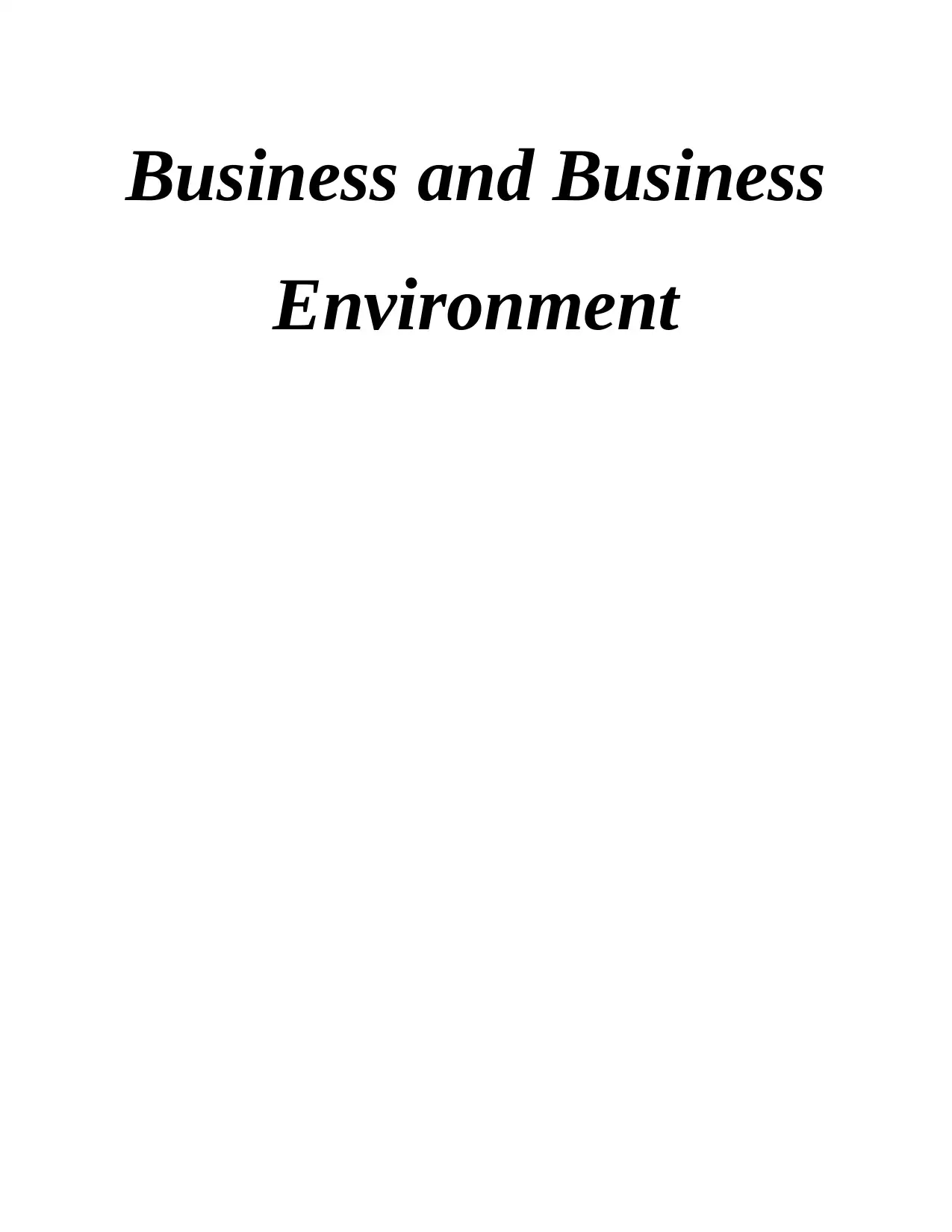
Business and Business
Environment
Environment
Paraphrase This Document
Need a fresh take? Get an instant paraphrase of this document with our AI Paraphraser
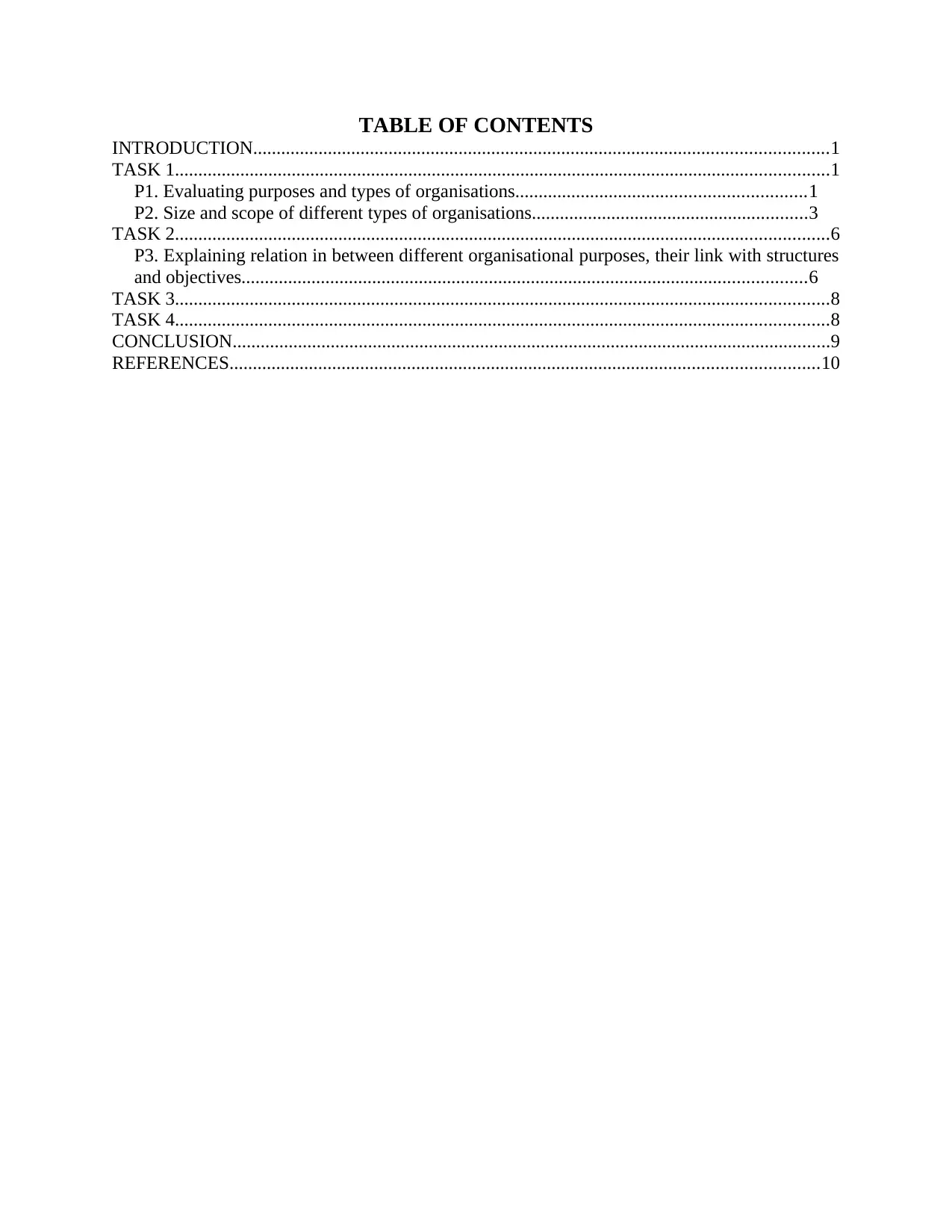
TABLE OF CONTENTS
INTRODUCTION...........................................................................................................................1
TASK 1............................................................................................................................................1
P1. Evaluating purposes and types of organisations..............................................................1
P2. Size and scope of different types of organisations...........................................................3
TASK 2............................................................................................................................................6
P3. Explaining relation in between different organisational purposes, their link with structures
and objectives.........................................................................................................................6
TASK 3............................................................................................................................................8
TASK 4............................................................................................................................................8
CONCLUSION................................................................................................................................9
REFERENCES..............................................................................................................................10
INTRODUCTION...........................................................................................................................1
TASK 1............................................................................................................................................1
P1. Evaluating purposes and types of organisations..............................................................1
P2. Size and scope of different types of organisations...........................................................3
TASK 2............................................................................................................................................6
P3. Explaining relation in between different organisational purposes, their link with structures
and objectives.........................................................................................................................6
TASK 3............................................................................................................................................8
TASK 4............................................................................................................................................8
CONCLUSION................................................................................................................................9
REFERENCES..............................................................................................................................10
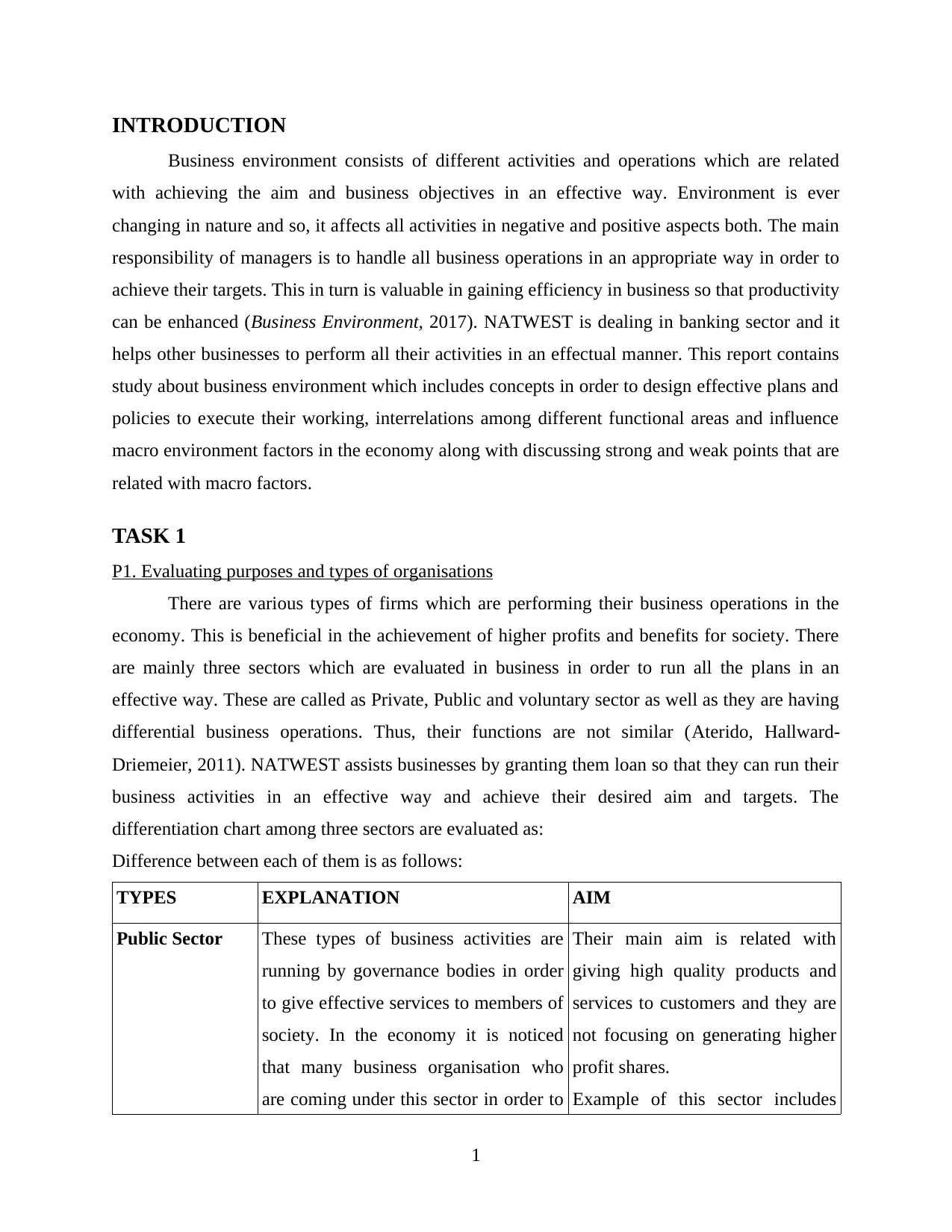
INTRODUCTION
Business environment consists of different activities and operations which are related
with achieving the aim and business objectives in an effective way. Environment is ever
changing in nature and so, it affects all activities in negative and positive aspects both. The main
responsibility of managers is to handle all business operations in an appropriate way in order to
achieve their targets. This in turn is valuable in gaining efficiency in business so that productivity
can be enhanced (Business Environment, 2017). NATWEST is dealing in banking sector and it
helps other businesses to perform all their activities in an effectual manner. This report contains
study about business environment which includes concepts in order to design effective plans and
policies to execute their working, interrelations among different functional areas and influence
macro environment factors in the economy along with discussing strong and weak points that are
related with macro factors.
TASK 1
P1. Evaluating purposes and types of organisations
There are various types of firms which are performing their business operations in the
economy. This is beneficial in the achievement of higher profits and benefits for society. There
are mainly three sectors which are evaluated in business in order to run all the plans in an
effective way. These are called as Private, Public and voluntary sector as well as they are having
differential business operations. Thus, their functions are not similar (Aterido, Hallward-
Driemeier, 2011). NATWEST assists businesses by granting them loan so that they can run their
business activities in an effective way and achieve their desired aim and targets. The
differentiation chart among three sectors are evaluated as:
Difference between each of them is as follows:
TYPES EXPLANATION AIM
Public Sector These types of business activities are
running by governance bodies in order
to give effective services to members of
society. In the economy it is noticed
that many business organisation who
are coming under this sector in order to
Their main aim is related with
giving high quality products and
services to customers and they are
not focusing on generating higher
profit shares.
Example of this sector includes
1
Business environment consists of different activities and operations which are related
with achieving the aim and business objectives in an effective way. Environment is ever
changing in nature and so, it affects all activities in negative and positive aspects both. The main
responsibility of managers is to handle all business operations in an appropriate way in order to
achieve their targets. This in turn is valuable in gaining efficiency in business so that productivity
can be enhanced (Business Environment, 2017). NATWEST is dealing in banking sector and it
helps other businesses to perform all their activities in an effectual manner. This report contains
study about business environment which includes concepts in order to design effective plans and
policies to execute their working, interrelations among different functional areas and influence
macro environment factors in the economy along with discussing strong and weak points that are
related with macro factors.
TASK 1
P1. Evaluating purposes and types of organisations
There are various types of firms which are performing their business operations in the
economy. This is beneficial in the achievement of higher profits and benefits for society. There
are mainly three sectors which are evaluated in business in order to run all the plans in an
effective way. These are called as Private, Public and voluntary sector as well as they are having
differential business operations. Thus, their functions are not similar (Aterido, Hallward-
Driemeier, 2011). NATWEST assists businesses by granting them loan so that they can run their
business activities in an effective way and achieve their desired aim and targets. The
differentiation chart among three sectors are evaluated as:
Difference between each of them is as follows:
TYPES EXPLANATION AIM
Public Sector These types of business activities are
running by governance bodies in order
to give effective services to members of
society. In the economy it is noticed
that many business organisation who
are coming under this sector in order to
Their main aim is related with
giving high quality products and
services to customers and they are
not focusing on generating higher
profit shares.
Example of this sector includes
1
⊘ This is a preview!⊘
Do you want full access?
Subscribe today to unlock all pages.

Trusted by 1+ million students worldwide
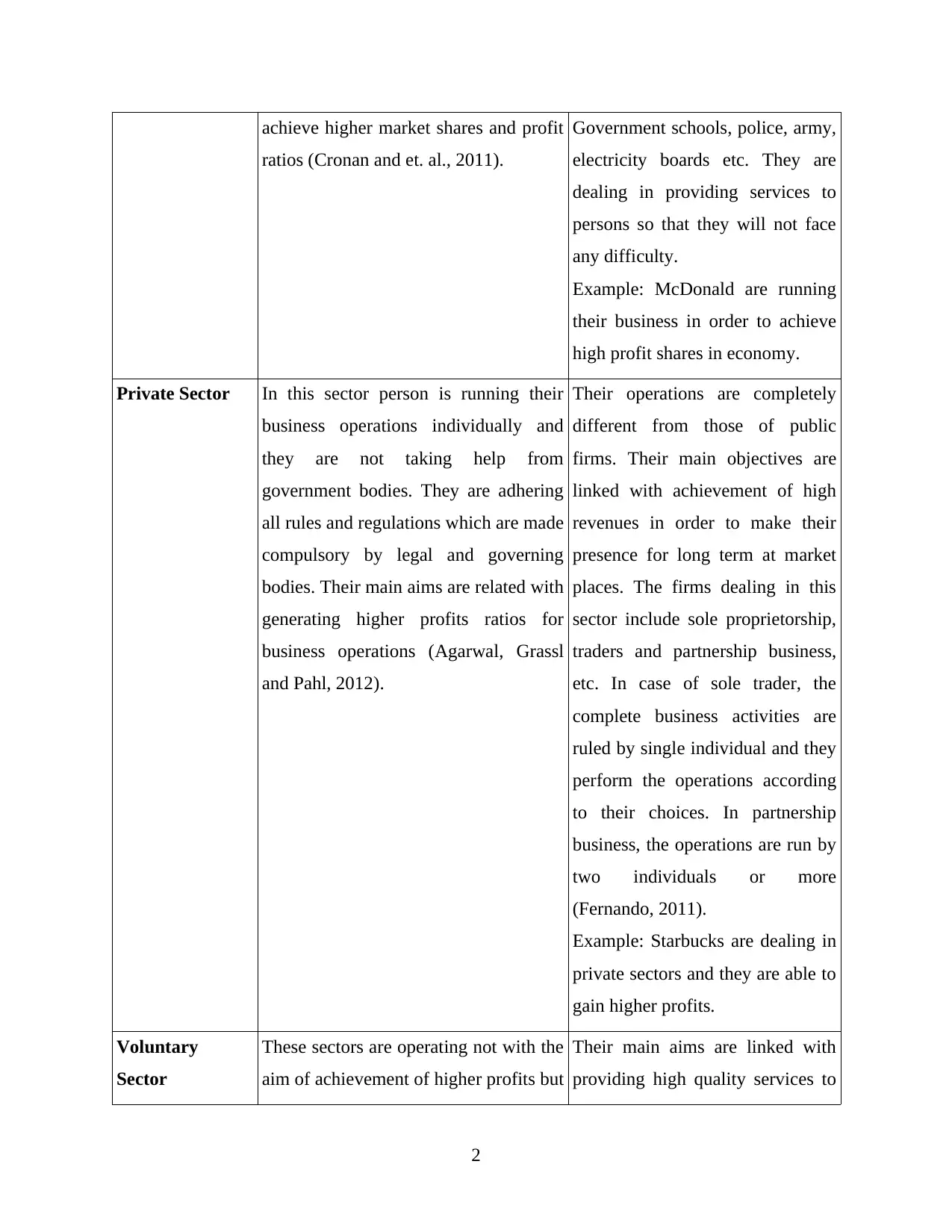
achieve higher market shares and profit
ratios (Cronan and et. al., 2011).
Government schools, police, army,
electricity boards etc. They are
dealing in providing services to
persons so that they will not face
any difficulty.
Example: McDonald are running
their business in order to achieve
high profit shares in economy.
Private Sector In this sector person is running their
business operations individually and
they are not taking help from
government bodies. They are adhering
all rules and regulations which are made
compulsory by legal and governing
bodies. Their main aims are related with
generating higher profits ratios for
business operations (Agarwal, Grassl
and Pahl, 2012).
Their operations are completely
different from those of public
firms. Their main objectives are
linked with achievement of high
revenues in order to make their
presence for long term at market
places. The firms dealing in this
sector include sole proprietorship,
traders and partnership business,
etc. In case of sole trader, the
complete business activities are
ruled by single individual and they
perform the operations according
to their choices. In partnership
business, the operations are run by
two individuals or more
(Fernando, 2011).
Example: Starbucks are dealing in
private sectors and they are able to
gain higher profits.
Voluntary
Sector
These sectors are operating not with the
aim of achievement of higher profits but
Their main aims are linked with
providing high quality services to
2
ratios (Cronan and et. al., 2011).
Government schools, police, army,
electricity boards etc. They are
dealing in providing services to
persons so that they will not face
any difficulty.
Example: McDonald are running
their business in order to achieve
high profit shares in economy.
Private Sector In this sector person is running their
business operations individually and
they are not taking help from
government bodies. They are adhering
all rules and regulations which are made
compulsory by legal and governing
bodies. Their main aims are related with
generating higher profits ratios for
business operations (Agarwal, Grassl
and Pahl, 2012).
Their operations are completely
different from those of public
firms. Their main objectives are
linked with achievement of high
revenues in order to make their
presence for long term at market
places. The firms dealing in this
sector include sole proprietorship,
traders and partnership business,
etc. In case of sole trader, the
complete business activities are
ruled by single individual and they
perform the operations according
to their choices. In partnership
business, the operations are run by
two individuals or more
(Fernando, 2011).
Example: Starbucks are dealing in
private sectors and they are able to
gain higher profits.
Voluntary
Sector
These sectors are operating not with the
aim of achievement of higher profits but
Their main aims are linked with
providing high quality services to
2
Paraphrase This Document
Need a fresh take? Get an instant paraphrase of this document with our AI Paraphraser
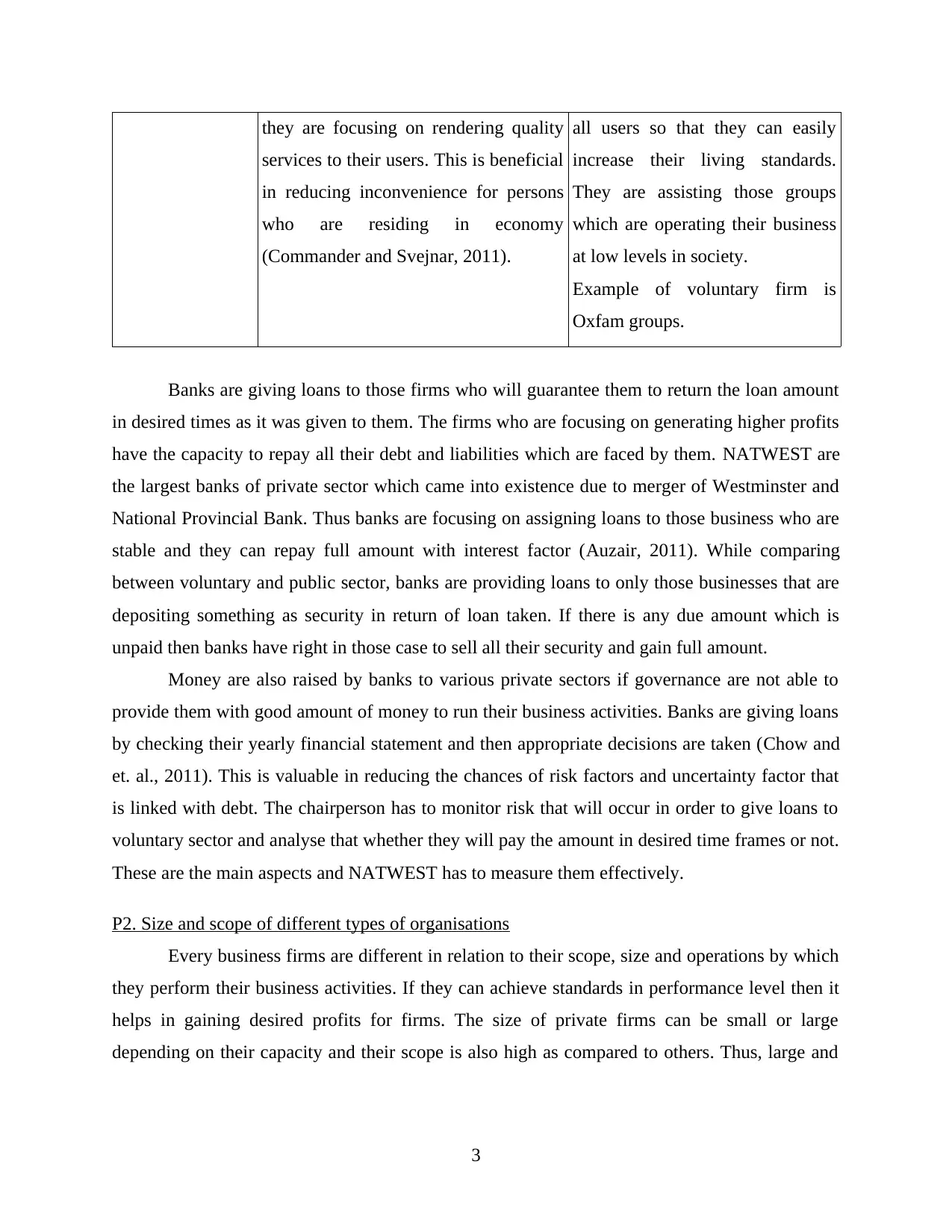
they are focusing on rendering quality
services to their users. This is beneficial
in reducing inconvenience for persons
who are residing in economy
(Commander and Svejnar, 2011).
all users so that they can easily
increase their living standards.
They are assisting those groups
which are operating their business
at low levels in society.
Example of voluntary firm is
Oxfam groups.
Banks are giving loans to those firms who will guarantee them to return the loan amount
in desired times as it was given to them. The firms who are focusing on generating higher profits
have the capacity to repay all their debt and liabilities which are faced by them. NATWEST are
the largest banks of private sector which came into existence due to merger of Westminster and
National Provincial Bank. Thus banks are focusing on assigning loans to those business who are
stable and they can repay full amount with interest factor (Auzair, 2011). While comparing
between voluntary and public sector, banks are providing loans to only those businesses that are
depositing something as security in return of loan taken. If there is any due amount which is
unpaid then banks have right in those case to sell all their security and gain full amount.
Money are also raised by banks to various private sectors if governance are not able to
provide them with good amount of money to run their business activities. Banks are giving loans
by checking their yearly financial statement and then appropriate decisions are taken (Chow and
et. al., 2011). This is valuable in reducing the chances of risk factors and uncertainty factor that
is linked with debt. The chairperson has to monitor risk that will occur in order to give loans to
voluntary sector and analyse that whether they will pay the amount in desired time frames or not.
These are the main aspects and NATWEST has to measure them effectively.
P2. Size and scope of different types of organisations
Every business firms are different in relation to their scope, size and operations by which
they perform their business activities. If they can achieve standards in performance level then it
helps in gaining desired profits for firms. The size of private firms can be small or large
depending on their capacity and their scope is also high as compared to others. Thus, large and
3
services to their users. This is beneficial
in reducing inconvenience for persons
who are residing in economy
(Commander and Svejnar, 2011).
all users so that they can easily
increase their living standards.
They are assisting those groups
which are operating their business
at low levels in society.
Example of voluntary firm is
Oxfam groups.
Banks are giving loans to those firms who will guarantee them to return the loan amount
in desired times as it was given to them. The firms who are focusing on generating higher profits
have the capacity to repay all their debt and liabilities which are faced by them. NATWEST are
the largest banks of private sector which came into existence due to merger of Westminster and
National Provincial Bank. Thus banks are focusing on assigning loans to those business who are
stable and they can repay full amount with interest factor (Auzair, 2011). While comparing
between voluntary and public sector, banks are providing loans to only those businesses that are
depositing something as security in return of loan taken. If there is any due amount which is
unpaid then banks have right in those case to sell all their security and gain full amount.
Money are also raised by banks to various private sectors if governance are not able to
provide them with good amount of money to run their business activities. Banks are giving loans
by checking their yearly financial statement and then appropriate decisions are taken (Chow and
et. al., 2011). This is valuable in reducing the chances of risk factors and uncertainty factor that
is linked with debt. The chairperson has to monitor risk that will occur in order to give loans to
voluntary sector and analyse that whether they will pay the amount in desired time frames or not.
These are the main aspects and NATWEST has to measure them effectively.
P2. Size and scope of different types of organisations
Every business firms are different in relation to their scope, size and operations by which
they perform their business activities. If they can achieve standards in performance level then it
helps in gaining desired profits for firms. The size of private firms can be small or large
depending on their capacity and their scope is also high as compared to others. Thus, large and
3
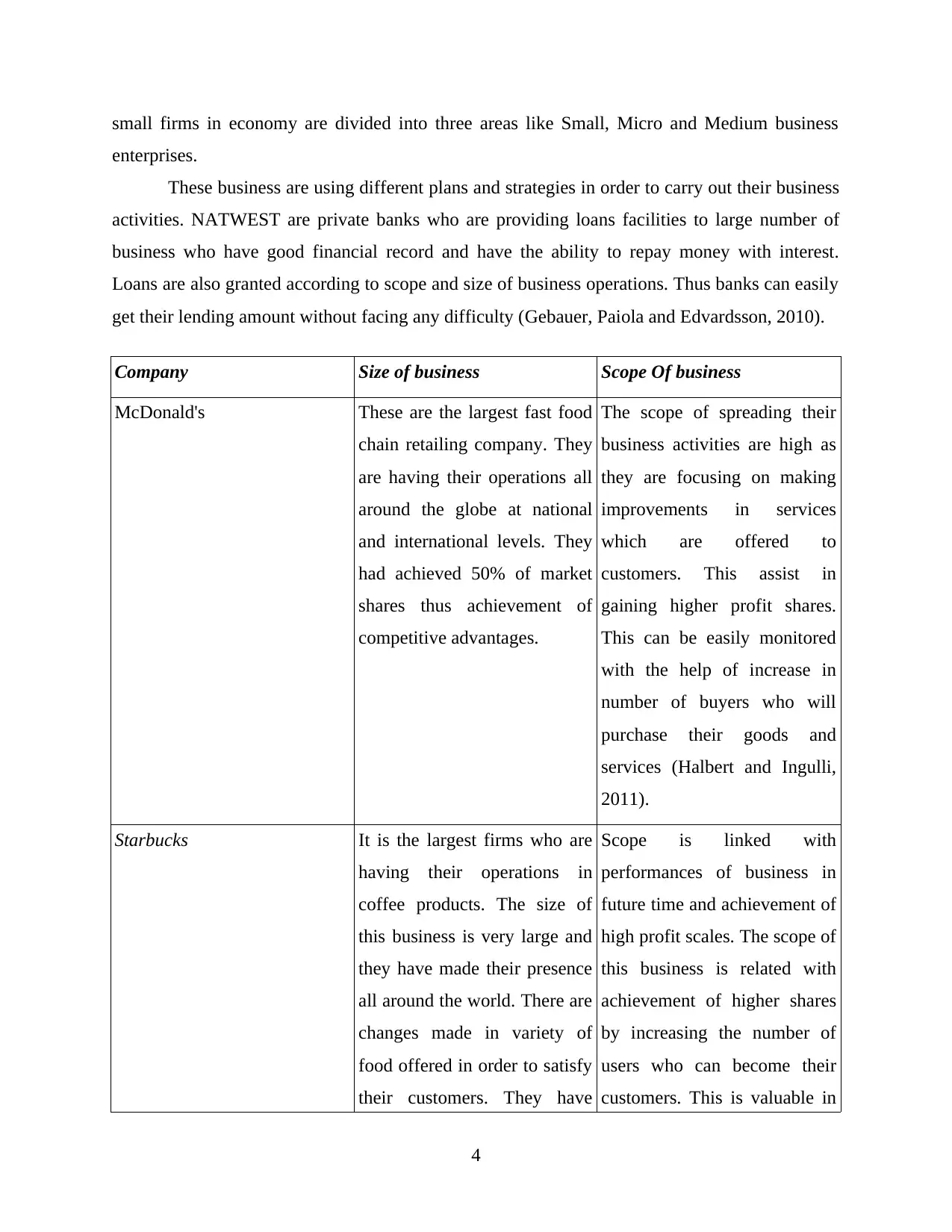
small firms in economy are divided into three areas like Small, Micro and Medium business
enterprises.
These business are using different plans and strategies in order to carry out their business
activities. NATWEST are private banks who are providing loans facilities to large number of
business who have good financial record and have the ability to repay money with interest.
Loans are also granted according to scope and size of business operations. Thus banks can easily
get their lending amount without facing any difficulty (Gebauer, Paiola and Edvardsson, 2010).
Company Size of business Scope Of business
McDonald's These are the largest fast food
chain retailing company. They
are having their operations all
around the globe at national
and international levels. They
had achieved 50% of market
shares thus achievement of
competitive advantages.
The scope of spreading their
business activities are high as
they are focusing on making
improvements in services
which are offered to
customers. This assist in
gaining higher profit shares.
This can be easily monitored
with the help of increase in
number of buyers who will
purchase their goods and
services (Halbert and Ingulli,
2011).
Starbucks It is the largest firms who are
having their operations in
coffee products. The size of
this business is very large and
they have made their presence
all around the world. There are
changes made in variety of
food offered in order to satisfy
their customers. They have
Scope is linked with
performances of business in
future time and achievement of
high profit scales. The scope of
this business is related with
achievement of higher shares
by increasing the number of
users who can become their
customers. This is valuable in
4
enterprises.
These business are using different plans and strategies in order to carry out their business
activities. NATWEST are private banks who are providing loans facilities to large number of
business who have good financial record and have the ability to repay money with interest.
Loans are also granted according to scope and size of business operations. Thus banks can easily
get their lending amount without facing any difficulty (Gebauer, Paiola and Edvardsson, 2010).
Company Size of business Scope Of business
McDonald's These are the largest fast food
chain retailing company. They
are having their operations all
around the globe at national
and international levels. They
had achieved 50% of market
shares thus achievement of
competitive advantages.
The scope of spreading their
business activities are high as
they are focusing on making
improvements in services
which are offered to
customers. This assist in
gaining higher profit shares.
This can be easily monitored
with the help of increase in
number of buyers who will
purchase their goods and
services (Halbert and Ingulli,
2011).
Starbucks It is the largest firms who are
having their operations in
coffee products. The size of
this business is very large and
they have made their presence
all around the world. There are
changes made in variety of
food offered in order to satisfy
their customers. They have
Scope is linked with
performances of business in
future time and achievement of
high profit scales. The scope of
this business is related with
achievement of higher shares
by increasing the number of
users who can become their
customers. This is valuable in
4
⊘ This is a preview!⊘
Do you want full access?
Subscribe today to unlock all pages.

Trusted by 1+ million students worldwide
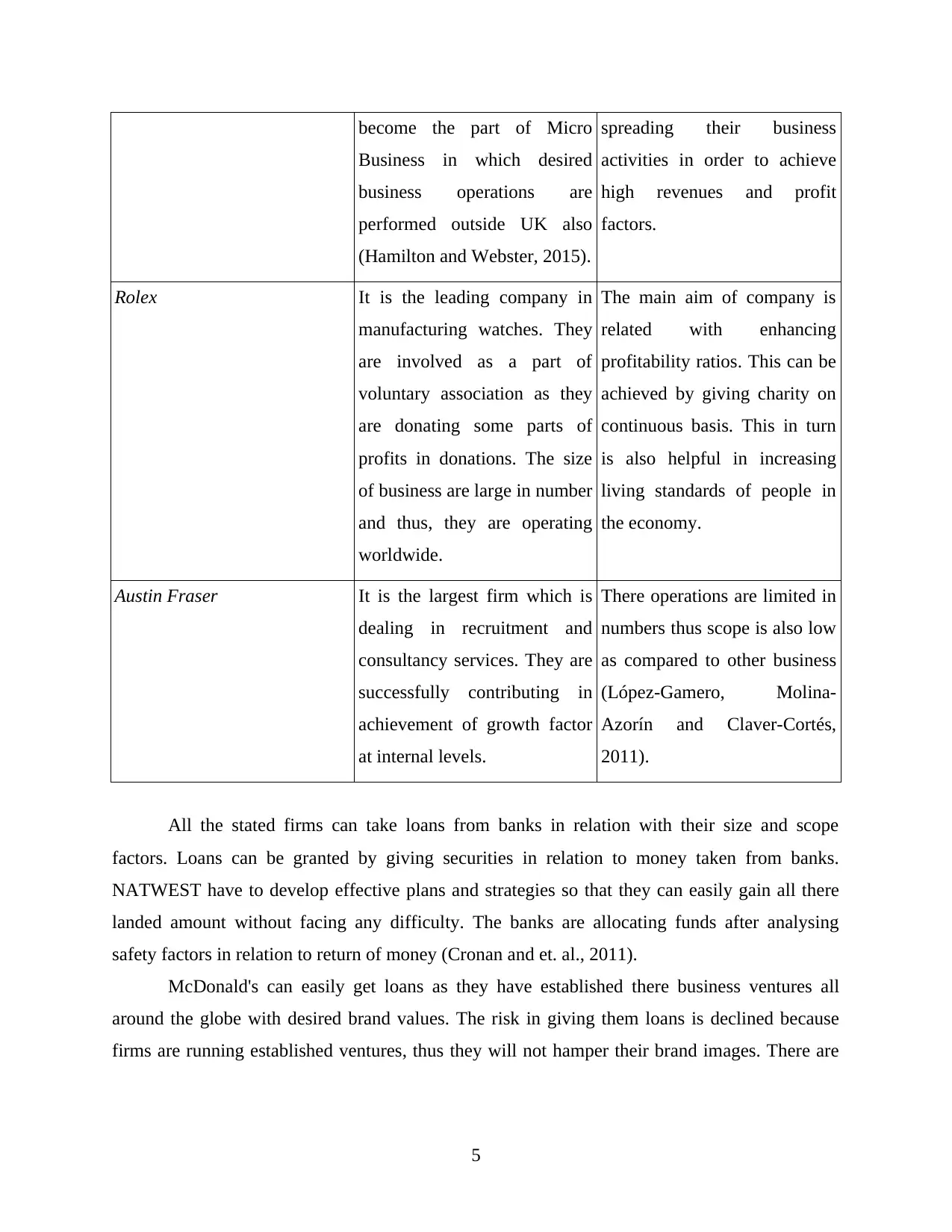
become the part of Micro
Business in which desired
business operations are
performed outside UK also
(Hamilton and Webster, 2015).
spreading their business
activities in order to achieve
high revenues and profit
factors.
Rolex It is the leading company in
manufacturing watches. They
are involved as a part of
voluntary association as they
are donating some parts of
profits in donations. The size
of business are large in number
and thus, they are operating
worldwide.
The main aim of company is
related with enhancing
profitability ratios. This can be
achieved by giving charity on
continuous basis. This in turn
is also helpful in increasing
living standards of people in
the economy.
Austin Fraser It is the largest firm which is
dealing in recruitment and
consultancy services. They are
successfully contributing in
achievement of growth factor
at internal levels.
There operations are limited in
numbers thus scope is also low
as compared to other business
(López-Gamero, Molina-
Azorín and Claver-Cortés,
2011).
All the stated firms can take loans from banks in relation with their size and scope
factors. Loans can be granted by giving securities in relation to money taken from banks.
NATWEST have to develop effective plans and strategies so that they can easily gain all there
landed amount without facing any difficulty. The banks are allocating funds after analysing
safety factors in relation to return of money (Cronan and et. al., 2011).
McDonald's can easily get loans as they have established there business ventures all
around the globe with desired brand values. The risk in giving them loans is declined because
firms are running established ventures, thus they will not hamper their brand images. There are
5
Business in which desired
business operations are
performed outside UK also
(Hamilton and Webster, 2015).
spreading their business
activities in order to achieve
high revenues and profit
factors.
Rolex It is the leading company in
manufacturing watches. They
are involved as a part of
voluntary association as they
are donating some parts of
profits in donations. The size
of business are large in number
and thus, they are operating
worldwide.
The main aim of company is
related with enhancing
profitability ratios. This can be
achieved by giving charity on
continuous basis. This in turn
is also helpful in increasing
living standards of people in
the economy.
Austin Fraser It is the largest firm which is
dealing in recruitment and
consultancy services. They are
successfully contributing in
achievement of growth factor
at internal levels.
There operations are limited in
numbers thus scope is also low
as compared to other business
(López-Gamero, Molina-
Azorín and Claver-Cortés,
2011).
All the stated firms can take loans from banks in relation with their size and scope
factors. Loans can be granted by giving securities in relation to money taken from banks.
NATWEST have to develop effective plans and strategies so that they can easily gain all there
landed amount without facing any difficulty. The banks are allocating funds after analysing
safety factors in relation to return of money (Cronan and et. al., 2011).
McDonald's can easily get loans as they have established there business ventures all
around the globe with desired brand values. The risk in giving them loans is declined because
firms are running established ventures, thus they will not hamper their brand images. There are
5
Paraphrase This Document
Need a fresh take? Get an instant paraphrase of this document with our AI Paraphraser
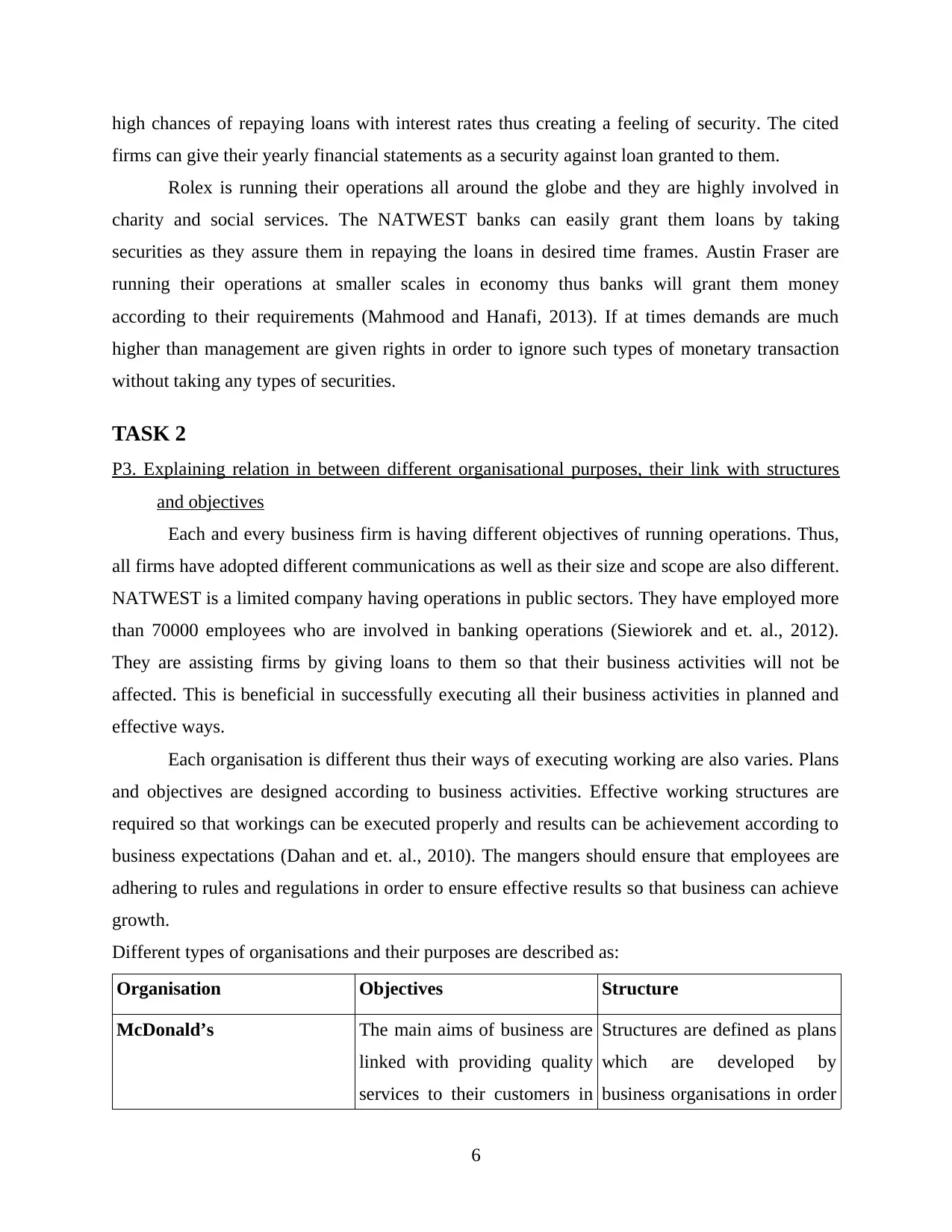
high chances of repaying loans with interest rates thus creating a feeling of security. The cited
firms can give their yearly financial statements as a security against loan granted to them.
Rolex is running their operations all around the globe and they are highly involved in
charity and social services. The NATWEST banks can easily grant them loans by taking
securities as they assure them in repaying the loans in desired time frames. Austin Fraser are
running their operations at smaller scales in economy thus banks will grant them money
according to their requirements (Mahmood and Hanafi, 2013). If at times demands are much
higher than management are given rights in order to ignore such types of monetary transaction
without taking any types of securities.
TASK 2
P3. Explaining relation in between different organisational purposes, their link with structures
and objectives
Each and every business firm is having different objectives of running operations. Thus,
all firms have adopted different communications as well as their size and scope are also different.
NATWEST is a limited company having operations in public sectors. They have employed more
than 70000 employees who are involved in banking operations (Siewiorek and et. al., 2012).
They are assisting firms by giving loans to them so that their business activities will not be
affected. This is beneficial in successfully executing all their business activities in planned and
effective ways.
Each organisation is different thus their ways of executing working are also varies. Plans
and objectives are designed according to business activities. Effective working structures are
required so that workings can be executed properly and results can be achievement according to
business expectations (Dahan and et. al., 2010). The mangers should ensure that employees are
adhering to rules and regulations in order to ensure effective results so that business can achieve
growth.
Different types of organisations and their purposes are described as:
Organisation Objectives Structure
McDonald’s The main aims of business are
linked with providing quality
services to their customers in
Structures are defined as plans
which are developed by
business organisations in order
6
firms can give their yearly financial statements as a security against loan granted to them.
Rolex is running their operations all around the globe and they are highly involved in
charity and social services. The NATWEST banks can easily grant them loans by taking
securities as they assure them in repaying the loans in desired time frames. Austin Fraser are
running their operations at smaller scales in economy thus banks will grant them money
according to their requirements (Mahmood and Hanafi, 2013). If at times demands are much
higher than management are given rights in order to ignore such types of monetary transaction
without taking any types of securities.
TASK 2
P3. Explaining relation in between different organisational purposes, their link with structures
and objectives
Each and every business firm is having different objectives of running operations. Thus,
all firms have adopted different communications as well as their size and scope are also different.
NATWEST is a limited company having operations in public sectors. They have employed more
than 70000 employees who are involved in banking operations (Siewiorek and et. al., 2012).
They are assisting firms by giving loans to them so that their business activities will not be
affected. This is beneficial in successfully executing all their business activities in planned and
effective ways.
Each organisation is different thus their ways of executing working are also varies. Plans
and objectives are designed according to business activities. Effective working structures are
required so that workings can be executed properly and results can be achievement according to
business expectations (Dahan and et. al., 2010). The mangers should ensure that employees are
adhering to rules and regulations in order to ensure effective results so that business can achieve
growth.
Different types of organisations and their purposes are described as:
Organisation Objectives Structure
McDonald’s The main aims of business are
linked with providing quality
services to their customers in
Structures are defined as plans
which are developed by
business organisations in order
6
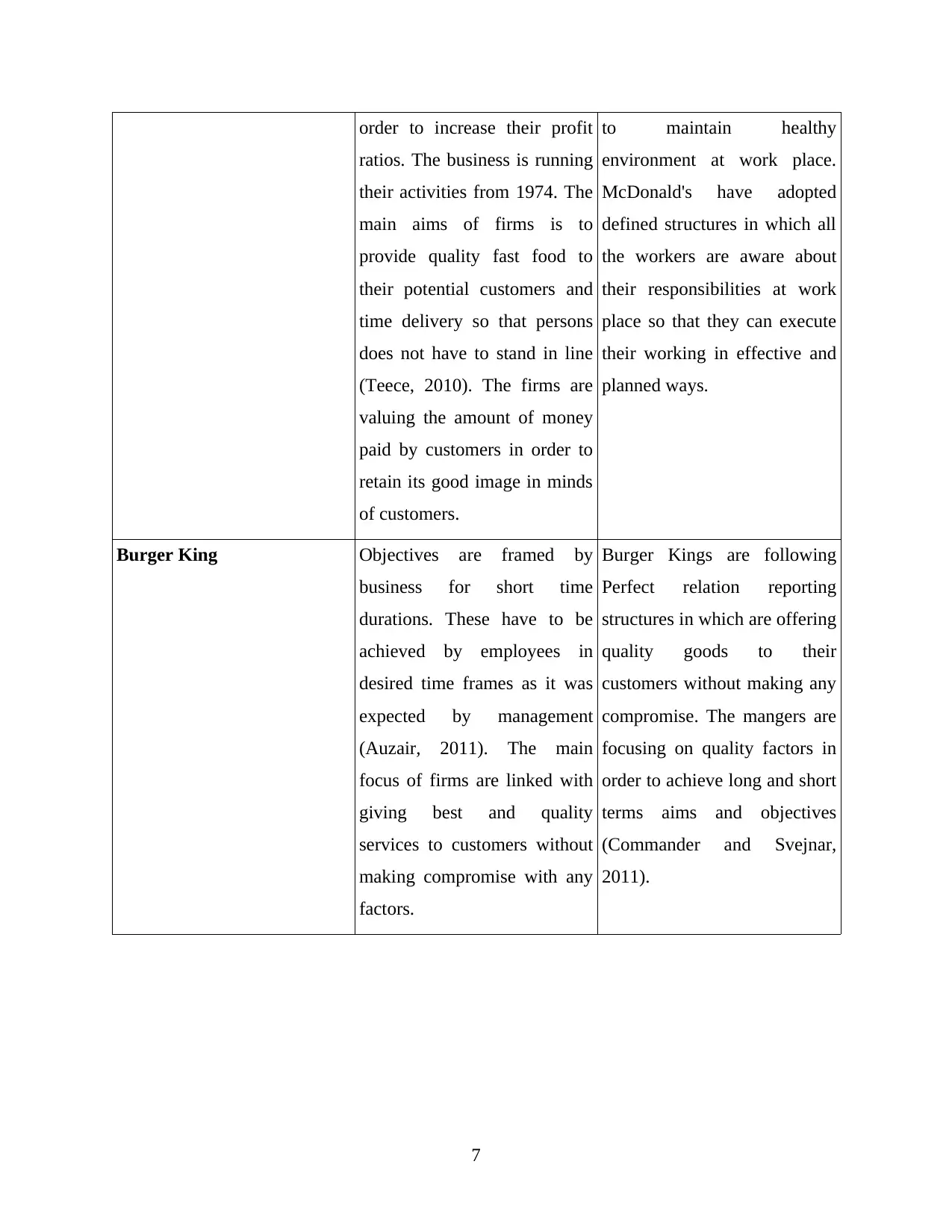
order to increase their profit
ratios. The business is running
their activities from 1974. The
main aims of firms is to
provide quality fast food to
their potential customers and
time delivery so that persons
does not have to stand in line
(Teece, 2010). The firms are
valuing the amount of money
paid by customers in order to
retain its good image in minds
of customers.
to maintain healthy
environment at work place.
McDonald's have adopted
defined structures in which all
the workers are aware about
their responsibilities at work
place so that they can execute
their working in effective and
planned ways.
Burger King Objectives are framed by
business for short time
durations. These have to be
achieved by employees in
desired time frames as it was
expected by management
(Auzair, 2011). The main
focus of firms are linked with
giving best and quality
services to customers without
making compromise with any
factors.
Burger Kings are following
Perfect relation reporting
structures in which are offering
quality goods to their
customers without making any
compromise. The mangers are
focusing on quality factors in
order to achieve long and short
terms aims and objectives
(Commander and Svejnar,
2011).
7
ratios. The business is running
their activities from 1974. The
main aims of firms is to
provide quality fast food to
their potential customers and
time delivery so that persons
does not have to stand in line
(Teece, 2010). The firms are
valuing the amount of money
paid by customers in order to
retain its good image in minds
of customers.
to maintain healthy
environment at work place.
McDonald's have adopted
defined structures in which all
the workers are aware about
their responsibilities at work
place so that they can execute
their working in effective and
planned ways.
Burger King Objectives are framed by
business for short time
durations. These have to be
achieved by employees in
desired time frames as it was
expected by management
(Auzair, 2011). The main
focus of firms are linked with
giving best and quality
services to customers without
making compromise with any
factors.
Burger Kings are following
Perfect relation reporting
structures in which are offering
quality goods to their
customers without making any
compromise. The mangers are
focusing on quality factors in
order to achieve long and short
terms aims and objectives
(Commander and Svejnar,
2011).
7
⊘ This is a preview!⊘
Do you want full access?
Subscribe today to unlock all pages.

Trusted by 1+ million students worldwide
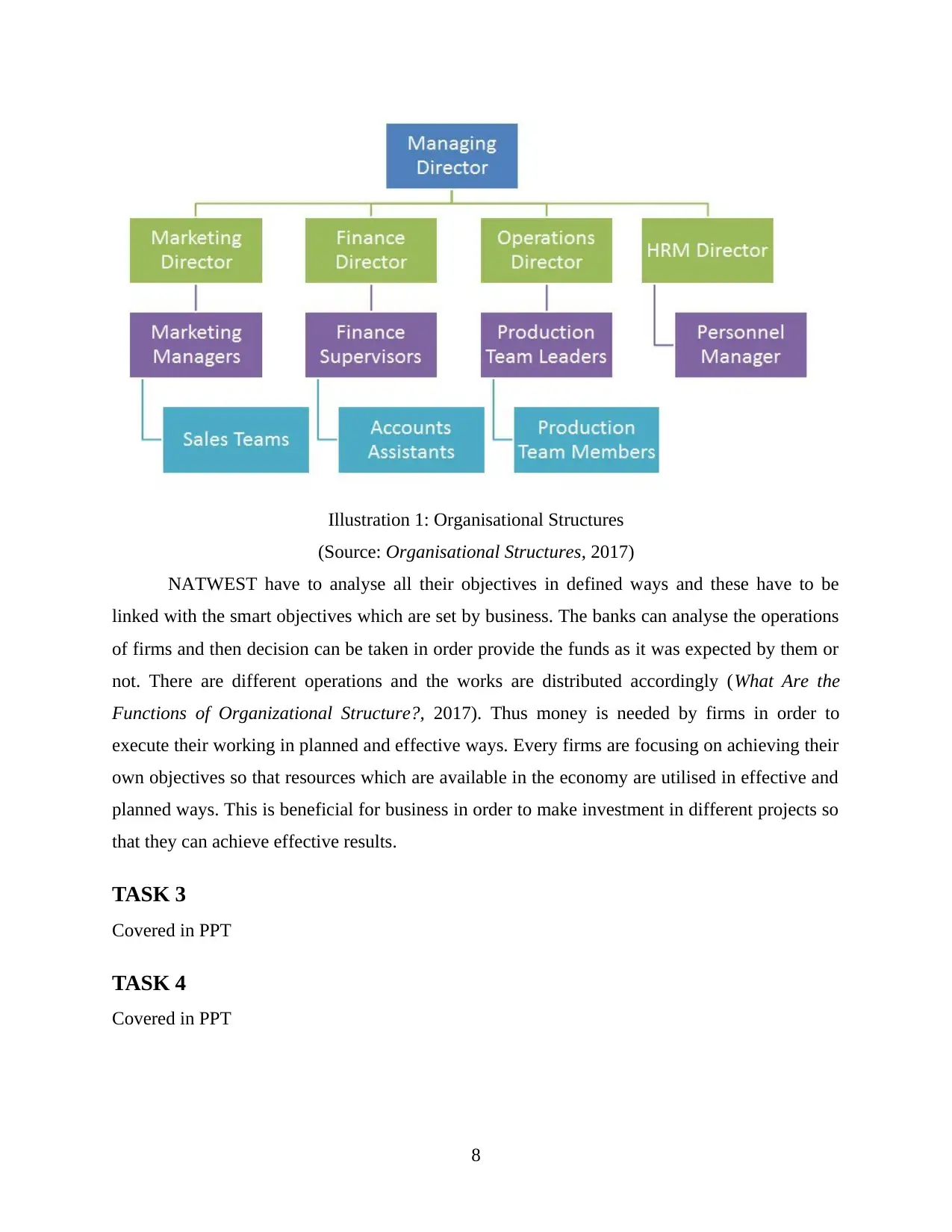
Illustration 1: Organisational Structures
(Source: Organisational Structures, 2017)
NATWEST have to analyse all their objectives in defined ways and these have to be
linked with the smart objectives which are set by business. The banks can analyse the operations
of firms and then decision can be taken in order provide the funds as it was expected by them or
not. There are different operations and the works are distributed accordingly (What Are the
Functions of Organizational Structure?, 2017). Thus money is needed by firms in order to
execute their working in planned and effective ways. Every firms are focusing on achieving their
own objectives so that resources which are available in the economy are utilised in effective and
planned ways. This is beneficial for business in order to make investment in different projects so
that they can achieve effective results.
TASK 3
Covered in PPT
TASK 4
Covered in PPT
8
(Source: Organisational Structures, 2017)
NATWEST have to analyse all their objectives in defined ways and these have to be
linked with the smart objectives which are set by business. The banks can analyse the operations
of firms and then decision can be taken in order provide the funds as it was expected by them or
not. There are different operations and the works are distributed accordingly (What Are the
Functions of Organizational Structure?, 2017). Thus money is needed by firms in order to
execute their working in planned and effective ways. Every firms are focusing on achieving their
own objectives so that resources which are available in the economy are utilised in effective and
planned ways. This is beneficial for business in order to make investment in different projects so
that they can achieve effective results.
TASK 3
Covered in PPT
TASK 4
Covered in PPT
8
Paraphrase This Document
Need a fresh take? Get an instant paraphrase of this document with our AI Paraphraser
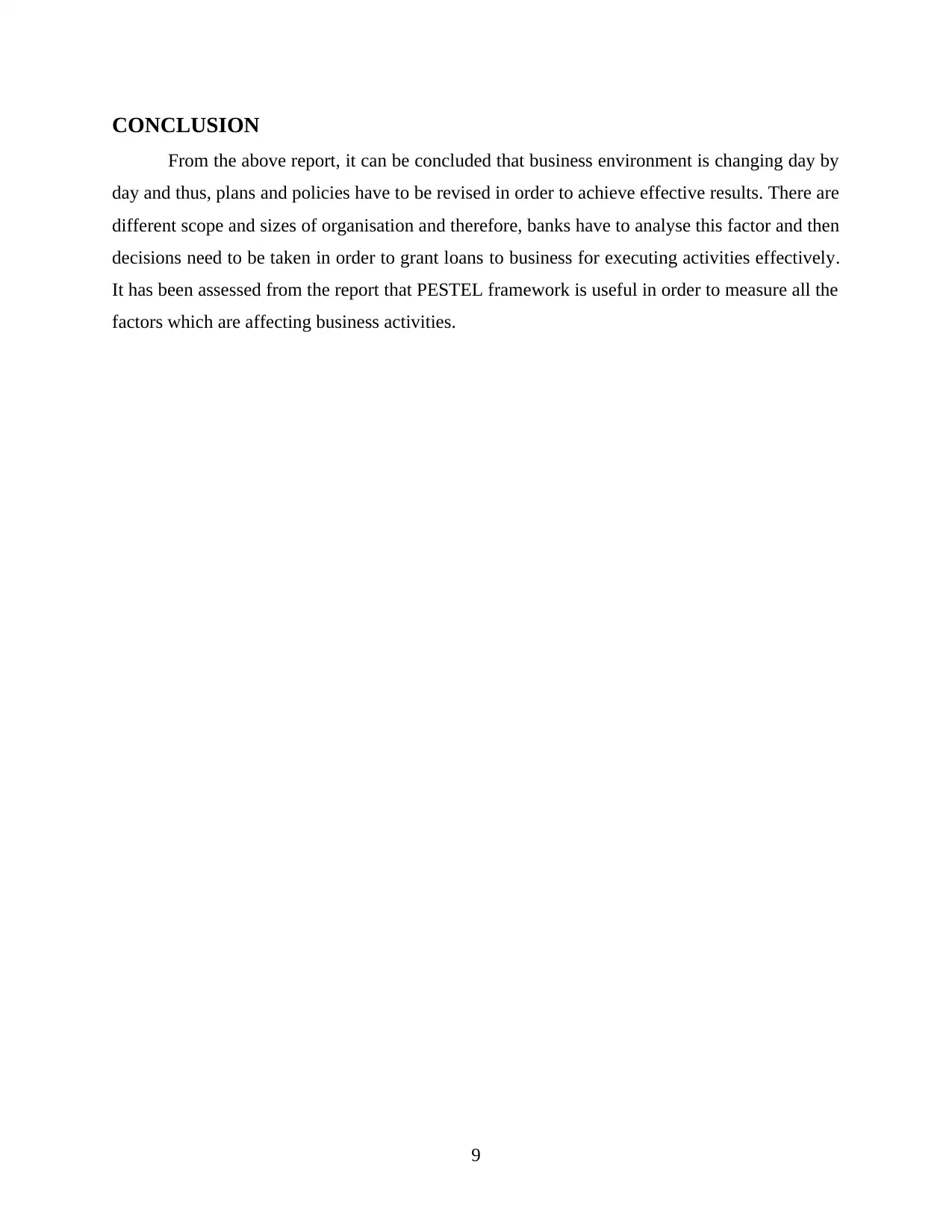
CONCLUSION
From the above report, it can be concluded that business environment is changing day by
day and thus, plans and policies have to be revised in order to achieve effective results. There are
different scope and sizes of organisation and therefore, banks have to analyse this factor and then
decisions need to be taken in order to grant loans to business for executing activities effectively.
It has been assessed from the report that PESTEL framework is useful in order to measure all the
factors which are affecting business activities.
9
From the above report, it can be concluded that business environment is changing day by
day and thus, plans and policies have to be revised in order to achieve effective results. There are
different scope and sizes of organisation and therefore, banks have to analyse this factor and then
decisions need to be taken in order to grant loans to business for executing activities effectively.
It has been assessed from the report that PESTEL framework is useful in order to measure all the
factors which are affecting business activities.
9
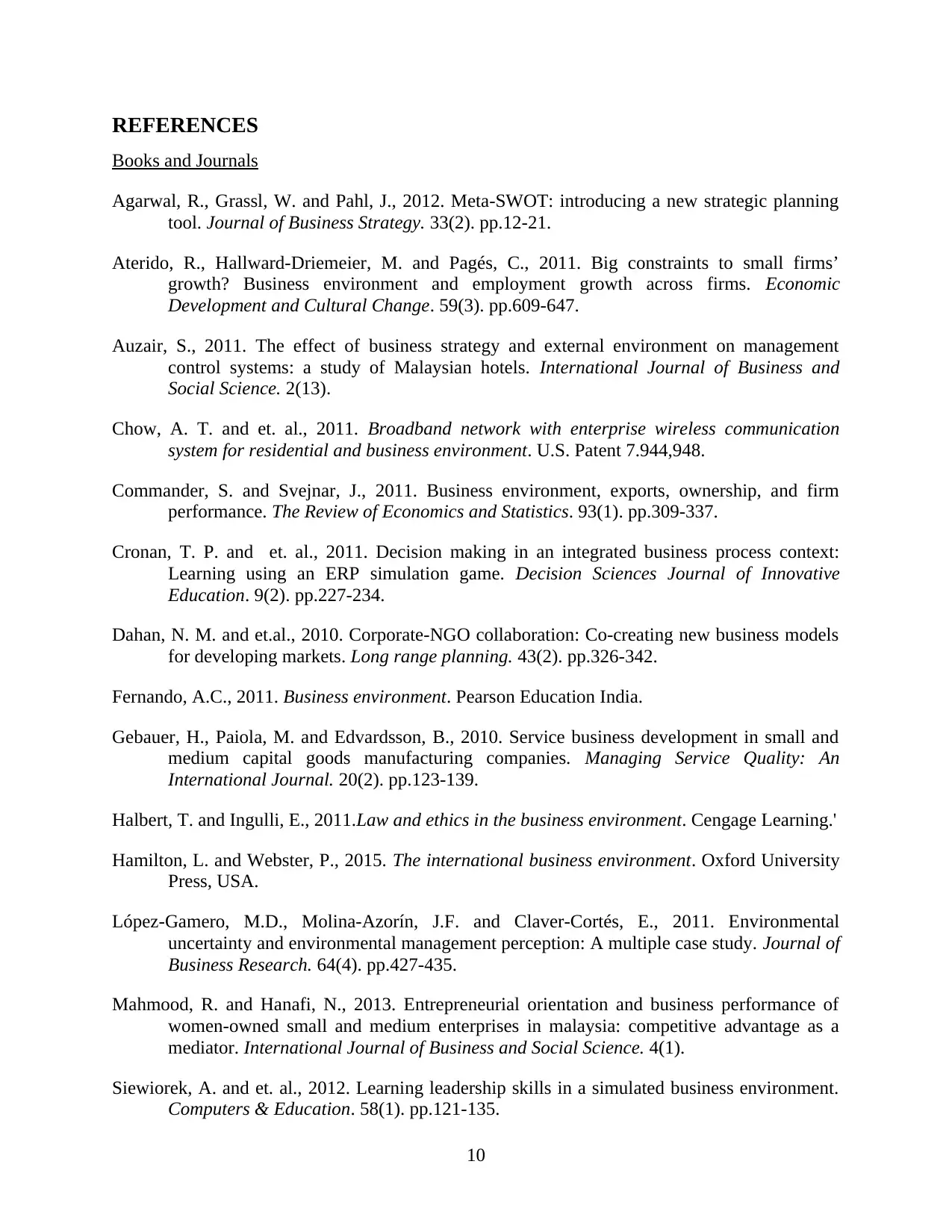
REFERENCES
Books and Journals
Agarwal, R., Grassl, W. and Pahl, J., 2012. Meta-SWOT: introducing a new strategic planning
tool. Journal of Business Strategy. 33(2). pp.12-21.
Aterido, R., Hallward-Driemeier, M. and Pagés, C., 2011. Big constraints to small firms’
growth? Business environment and employment growth across firms. Economic
Development and Cultural Change. 59(3). pp.609-647.
Auzair, S., 2011. The effect of business strategy and external environment on management
control systems: a study of Malaysian hotels. International Journal of Business and
Social Science. 2(13).
Chow, A. T. and et. al., 2011. Broadband network with enterprise wireless communication
system for residential and business environment. U.S. Patent 7.944,948.
Commander, S. and Svejnar, J., 2011. Business environment, exports, ownership, and firm
performance. The Review of Economics and Statistics. 93(1). pp.309-337.
Cronan, T. P. and et. al., 2011. Decision making in an integrated business process context:
Learning using an ERP simulation game. Decision Sciences Journal of Innovative
Education. 9(2). pp.227-234.
Dahan, N. M. and et.al., 2010. Corporate-NGO collaboration: Co-creating new business models
for developing markets. Long range planning. 43(2). pp.326-342.
Fernando, A.C., 2011. Business environment. Pearson Education India.
Gebauer, H., Paiola, M. and Edvardsson, B., 2010. Service business development in small and
medium capital goods manufacturing companies. Managing Service Quality: An
International Journal. 20(2). pp.123-139.
Halbert, T. and Ingulli, E., 2011.Law and ethics in the business environment. Cengage Learning.'
Hamilton, L. and Webster, P., 2015. The international business environment. Oxford University
Press, USA.
López-Gamero, M.D., Molina-Azorín, J.F. and Claver-Cortés, E., 2011. Environmental
uncertainty and environmental management perception: A multiple case study. Journal of
Business Research. 64(4). pp.427-435.
Mahmood, R. and Hanafi, N., 2013. Entrepreneurial orientation and business performance of
women-owned small and medium enterprises in malaysia: competitive advantage as a
mediator. International Journal of Business and Social Science. 4(1).
Siewiorek, A. and et. al., 2012. Learning leadership skills in a simulated business environment.
Computers & Education. 58(1). pp.121-135.
10
Books and Journals
Agarwal, R., Grassl, W. and Pahl, J., 2012. Meta-SWOT: introducing a new strategic planning
tool. Journal of Business Strategy. 33(2). pp.12-21.
Aterido, R., Hallward-Driemeier, M. and Pagés, C., 2011. Big constraints to small firms’
growth? Business environment and employment growth across firms. Economic
Development and Cultural Change. 59(3). pp.609-647.
Auzair, S., 2011. The effect of business strategy and external environment on management
control systems: a study of Malaysian hotels. International Journal of Business and
Social Science. 2(13).
Chow, A. T. and et. al., 2011. Broadband network with enterprise wireless communication
system for residential and business environment. U.S. Patent 7.944,948.
Commander, S. and Svejnar, J., 2011. Business environment, exports, ownership, and firm
performance. The Review of Economics and Statistics. 93(1). pp.309-337.
Cronan, T. P. and et. al., 2011. Decision making in an integrated business process context:
Learning using an ERP simulation game. Decision Sciences Journal of Innovative
Education. 9(2). pp.227-234.
Dahan, N. M. and et.al., 2010. Corporate-NGO collaboration: Co-creating new business models
for developing markets. Long range planning. 43(2). pp.326-342.
Fernando, A.C., 2011. Business environment. Pearson Education India.
Gebauer, H., Paiola, M. and Edvardsson, B., 2010. Service business development in small and
medium capital goods manufacturing companies. Managing Service Quality: An
International Journal. 20(2). pp.123-139.
Halbert, T. and Ingulli, E., 2011.Law and ethics in the business environment. Cengage Learning.'
Hamilton, L. and Webster, P., 2015. The international business environment. Oxford University
Press, USA.
López-Gamero, M.D., Molina-Azorín, J.F. and Claver-Cortés, E., 2011. Environmental
uncertainty and environmental management perception: A multiple case study. Journal of
Business Research. 64(4). pp.427-435.
Mahmood, R. and Hanafi, N., 2013. Entrepreneurial orientation and business performance of
women-owned small and medium enterprises in malaysia: competitive advantage as a
mediator. International Journal of Business and Social Science. 4(1).
Siewiorek, A. and et. al., 2012. Learning leadership skills in a simulated business environment.
Computers & Education. 58(1). pp.121-135.
10
⊘ This is a preview!⊘
Do you want full access?
Subscribe today to unlock all pages.

Trusted by 1+ million students worldwide
1 out of 13
Related Documents
Your All-in-One AI-Powered Toolkit for Academic Success.
+13062052269
info@desklib.com
Available 24*7 on WhatsApp / Email
![[object Object]](/_next/static/media/star-bottom.7253800d.svg)
Unlock your academic potential
Copyright © 2020–2025 A2Z Services. All Rights Reserved. Developed and managed by ZUCOL.





